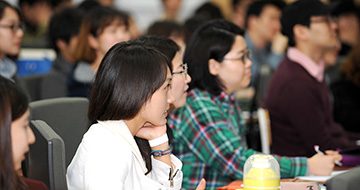Quick Menu 설정
※ 퀵메뉴 메뉴에 대한 사용자 설정을 위해 쿠키를 사용하고 있습니다. 메뉴 체크 후 저장을 한 경우 쿠키 저장에 동의한 것으로 간주됩니다.
국민인! 국민인!!
포스트코로나 사회를 위한 Environmental Hope연구 미국 워싱턴 책출판 / 데이비드 윌리엄 김(교양대학) 교수
- 작성자 박채원
- 작성일 24.01.30
- 조회수 632
영국 왕립역사학회(The Royal Historical Society, UK) 석학회원으로 활동하고 있는 교양대학 데이비드 윌리엄 김 (David William Kim)교수는 이번에 미국 Washington D.C.에서 최근연구결과물을 세계적인 인문사회전문 출판사인 Rowman & Littlefield; Lexington를 통해 출판하게 되었다. 이 책은 중세 암흑기의 Black Death를 방불케 하고Swine Flu Pandemic (2009–2010) and Ebola (2014–2016)의 두려움을 상기시키는 COVID-19 펜데믹 시기에 현대의학의 무방비속에 일반인, 크리스찬, 사회단체, 그리고 전세계국가들이 끝없는 공포와 죽음에 대한 두려움을 이겨 내기 위해 각자의 마음 속에 간직하고 있던 "희망"에 대해 논의분석 하였다. 이것을 "환경적인 희망"으로 정의한 연구가 관련분야 사회변동, 심리학, 인류학, 종교학, 의료보건, 공공정책분야의 학자들로 인정받아 포스터 코로나 시대를 해석하는 새로운 접근법을 제시하게 되었다. 아래는 원문의 (Environmental Hope: Socio-Anthropological Approaches to Religion) 일부 내용을 간략하게 소개하고 있다.
The COVID–19, following on from Swine Flu (2009–2010) and Ebola (2014–2016), was transmitted across the world regardless of wealth, nationality, ethnicity, age, gender and climate change. The latest science, technology, policies, and politics were powerless even though vaccine development slowed down the biological influence of the diseases over three years (2020–2023). The social pattern of 2-week quarantine or more became generalised, either at home or in restricted spaces. Travellers had to remain in a hotel room at their own expense. The psychological symptoms of fear, insecurity and restlessness were common issues in local communities. Vulnerable and marginalised people, including elder adults, patients, the homeless and individuals with disabilities were the first victims, lacking proper medical attention. The citizens of underdeveloped nations (e.g., Africa, Latin America and Asia) had fewer opportunities to secure prevention with access to vaccine supplies.
The Cambridge Dictionary defines the notion of ‘hope’ as a desirable thought ‘to want something to happen or to be true and usually have a good reason to think that it might’. The socio-cultural scope of hope covers the limitations of science and technology when they fail in their expected capacities. Even NASA astronauts and ground staff members in a personal sphere hope for the success of their space mission, even though their scientific logic is perfectly ready. The human behaviour of hope is a psychological anchor of confidence and security in any personal circumstance. This book’s idea of ‘environmental hope’ is not different. Additionally, it implies temporary figures of the subject in the context of religion’s ecological and anthropological behaviour. Under the pandemic (2020–2023), global communities, social classes and different generations often held onto hope.
Figure 11.1: Traditional cultural welcoming of the Anima Mundi team by the descendants of the sculptor, Munumba. Imboando village, Sepik River, 2018.
They are excellent sources in terms of providing perspectives on social modernisation. However, they lack an environmental approach to socio-psychological needs of contemporary communities, including the medical crisis and the incompetence of medical science. How did people or groups survive under the mental pressure of the COVID–19 challenges? How did the personal concerns of health, job, family, travel, and communication come to include the invisible and intangible concept of metaphysical security? The project, Socio-Anthropological Approaches to Religion: Environmental Hope uniquely interprets the fundamental functions of social religion and spirituality through the theories and practices of hope and understanding the aspirations of new religious movements. The expectation or uncertainty of hope is illustrated through case studies of a personal, community, social or global tendency.
Figure 11-2: A rare glimpse of the healing part of the initiation ceremony of the ‘crocodile men’. Palimbei village, Sepik River, 2018
Socio-Anthropological Approaches to Religion: Environmental Hope interprets the fundamental functions of spirituality through the theories and practices of hope and understanding the futuristic aspiration of new religious movements. The book portrays a neutral notion of hope that can be either religious or humanistic in the face of the suffering or despair of present reality. The concept of hope (or hopelessness) is demonstrated in each chapter under the global circumstance of health risk.
Part One represents the various theories of hope in Christian history, ecology and climate, the Sabbath and surveillance, and the triune God. The insecure situation that creates the expectation of hope is demonstrated in Part Two, where the case studies of terrorist attacks, immigration, volunteering behavior, religious education, and medieval Islamic tradition indicate social unbalance. The last section illustrates the cultural anthropology of hope through the activities of different native new religious movements including the Moonies’ Unification movement, Yoruba Nigerian indigenous spirituality, and Cosmovisions of Sepik New Guinea. This book examines hope as a crucial element of human’s internal healing beyond medical technology.
For the new book ($115.00), see: https://rowman.com/ISBN/9781666956054/Socio-Anthropological-Approaches-to-Religion-Environmental-Hope
















